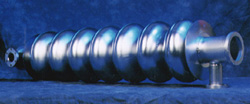Teaching Photons to Tango

Laser light can slice through steel, but the photons in the beam barely notice each other. This cool indifference of one photon to another is what allows thousands of telephone conversations and internet connections to inhabit the same fiber optic cable. But it also leaves some unfinished business for physicists eager to study photon-photon collisions–a phenomenon predicted by the theory of quantum electrodynamics (QED) but one that is nearly impossible to measure. In the 22 October print issue of PRL, a team in Sweden proposes a new way to foster just the right conditions to watch photons collide. Although the experiment wouldn’t involve lasers, if experimenters can pull it off, the observation might lead to new uses for the highest power lasers of the future.
Normally, photons just pass by each other, but in very rare cases two photons can scatter off one another when they exchange virtual particles–particles that photons constantly emit and reabsorb, according to QED. For years, high energy physicists have observed the interactions of virtual photons created in collisions of charged particles, but no one has ever seen real photons simply bounce off one another.
To overcome the low probability of photon-photon scattering, a group of theorists at two Swedish universities has proposed trapping lots of photons inside a so-called resonant cavity. This cavity concentrates photons of particular energies (modes), much like an organ pipe concentrates acoustic energy of certain frequencies. By pumping a lot of photons into just the right modes, photons of two different energies could smash into each other, exchange some of their energy, and then fly off with two new energies that were not among the original modes. The detection of these new photon energies would indicate the existence of photon-photon scattering, according to team member Mattias Marklund of the Chalmers University of Technology in Göteborg.
“It’s a nice proposal,” says Mordechai Segev of Princeton University, who has proposed searching for photon-photon scattering with high power lasers. He says that such scattering–if it could be observed–would be the first example of so-called nonlinear optics in vacuum, a class of optical effects that don’t normally occur without high power lasers and a material medium. Another example of such effects is self-focusing, where the light confines itself into a beam that doesn’t diverge. If this can be done in a vacuum instead of matter, says Segev, it might lend itself to some far-out applications. Assuming future lasers can be cranked up to the level where self-focusing occurs in a vacuum, then the beam could propagate over huge distances–maybe even from our galaxy to the one next door–without dissipating. Closer to home, the nonlinear effects might be used to create new laser frequencies at very high power, something laser physicists would be delighted to do.
Marklund hopes to try out their proposal using high power microwave cavities like ones currently used to boost beam power in particle accelerators. These can store huge quantities of photons, and they might reach the power needed for photon scattering, he says. The Swedish group is talking with Rutherford Laboratory in the UK about setting up resonant cavities to search for photon scattering in a couple of years.
–David Voss
David Voss is an editor for Physics.


